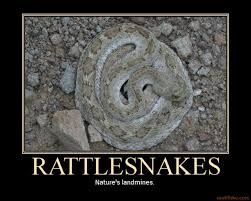
You are scrambling over some rocks while out on your adventure when you jump down only to be met with a sudden stinging pain and a chorus of tiny maracas. You have been bitten, but unfortunately for your girlfriend you won’t become a sparkly, moping vampire, you will begin to develop necrosis (the death of skin and muscle tissue cells around the bite area).
So what are you to do now that you’ve been bitten? First move away from the snake. The snake bit you because he felt threatened, not because he thought you would taste delicious.
After moving away, remember this next step through the rest of our snake encounter. In the words of the great Douglas Adams, “Don’t panic!”
A lot of old timers will tell you that you need to kill or capture the snake to bring with you to the Emergency Room. This is as bad as drunkenly texting your ex at 3am. The thing is they estimate that 20-25% of pit viper (rattlesnakes, copperheads) and 50% of coral snake bites are dry bites (the snake does not use venom). So chasing a snake around is sure to increase the likelihood that it will use venom. Just note the description of the snake and stay away. In North America there is only one type antivenom that treats bites from rattlesnakes, copperheads and cotton-mouth/water moccasins. The only outlying snake would be the coral snake.
Do not attempt to “suck” the venom out of the bite. While this makes for an entertaining comedy trope, it is not accepted first aid.
Some more old practices that we now know to be bad are:
- Do not put ice on the bite.
- Do not try to “bleed” out the poison by cutting between the fang marks.
- Do not use alcohol.
- DO NOT TOURNIQUET THE AFFECTED LIMB!
What you should do is remove anything that can become constrictive in the event of swelling (things like rings).
Attempt to immobilize the bitten area without constricting the flow of blood. Seek immediate medical attention from the local Emergency Room.
Remember throughout the event the key is to remain calm and don’t panic.
Recent Comments